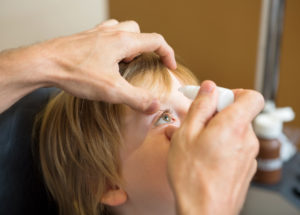August 1, 2023
By Dwight Akerman, OD, MBA, FAAO, FBCLA, FIACLE
 Eye care professionals frequently prescribe topical low-dose atropine to slow myopic Rx and axial length progression in children and adolescents. 0.01%, 0.03%, and 0.05% atropine are regularly prescribed as monotherapy or combined with other myopia therapies.
Eye care professionals frequently prescribe topical low-dose atropine to slow myopic Rx and axial length progression in children and adolescents. 0.01%, 0.03%, and 0.05% atropine are regularly prescribed as monotherapy or combined with other myopia therapies.
The effect of low-dose atropine on binocular vision measurements has not been thoroughly studied. This study aimed to determine the effect of three concentrations of atropine drops (0.01%, 0.03%, and 0.05%) on visual acuity, accommodation, pupil size, and binocular vision measurements.
A total of 46 children (28 girls and 18 boys) ages 6 to 17 years were recruited from the Illinois Eye Institute, an urban primary eye care clinic, to participate in this randomized double-masked study. Neither race/ethnicity nor iris color was factored into this pilot study due to the small sample size. The participants were randomized into four groups: placebo (n= 10), 0.01% (n=13), 0.03% (n= 11), or 0.05% (n= 12) atropine. One drop of atropine or placebo was administered into each eye once. The following measurements were collected before applying the eye drops and 30 minutes, 60 minutes, and 24 hours following application of eye drops: habitual visual acuity at distance and near, pupil size, dissociated phoria at distance and near, negative and positive fusional vergence, near point convergence, near point convergence stamina and fragility, accommodative lag, and amplitude of accommodation.
Compared to an age-matched and refractive error-matched control group, the researchers found no significant effect on visual acuity, binocular vision, or accommodation measurements with respect to time and atropine concentration. Pupil size was enlarged in the 0.01% atropine group at 60 minutes. However, this effect dissipated by 24 hours. Although both 0.03% and 0.05% atropine eye drops increased pupil size in photopic and scotopic conditions, visual acuity, accommodation, and binocular vision function remained unaffected.
The researchers concluded that topical low-dose atropine eye drops have no significant effect on accommodation, binocular vision measurements, or visual acuity compared to control in children ages 6 to 17 years.
Abstract
Effect of Low-Dose Atropine on Binocular Vision and Accommodation in Children Ages 6 to 17 Years
Rachel Breliant , Yi Pang, Alaina Bandstra, Valerie Kattouf
Significance: Low-dose atropine is one of the leading treatments for myopia progression in children. However, the effect of low-dose atropine on binocular vision measurements has not been thoroughly studied.
Purpose: To determine the effect of 0.01%, 0.03%, and 0.05% atropine on visual acuity, pupil size, binocular vision, and accommodation in children aged 6 to 17 years.
Methods: Forty-six children (28 girls and 18 boys) were randomized into four groups: placebo (n = 10), 0.01% (n = 13), 0.03% (n = 11), or 0.05% (n = 12) atropine. One drop of atropine or placebo was administered into each eye once. The following measurements were collected before applying the eye drops and 30 minutes, 60 minutes, and 24 hours following application of eye drops: habitual visual acuity at distance and near, pupil size, dissociated phoria at distance and near, negative and positive fusional vergence, near point convergence, near point convergence stamina and fragility, accommodative lag, and amplitude of accommodation. Repeated measures ANOVA was utilized, and a P < .05 was considered statistically significant.
Results: Differences in pupil diameters under photopic and scotopic conditions were statistically significant when comparing all three atropine groups to placebo over time (Ps < .001). Pupil size in both the 0.03% and 0.05% atropine group was enlarged from baseline at the 30-minute, 60-minute, and 24-hour time points (Ps < .05) in both photopic and scotopic conditions. Pupil size in the 0.01% atropine group had minimal change; only the scotopic 60-minute time point was statistically significant (P = .02). All three concentrations of atropine eye drops have no significant effect on accommodation, binocular vision measurements, or visual acuity compared to the control group.
Conclusions: Pupil size was significantly enlarged by 0.03% and 0.05% atropine in both photopic and scotopic conditions. Low-dose atropine eye drops have no significant effect on accommodation, binocular vision measurements, or visual acuity compared to control.
Breliant, R., Pang, Y., Bandstra, A., & Kattouf, V. (2023). Effect of Low-dose Atropine on Binocular Vision and Accommodation in Children Ages 6 to 17 Years. Optometry and Vision Science: Official Publication of the American Academy of Optometry.
DOI: 10.1097/opx.0000000000002031













